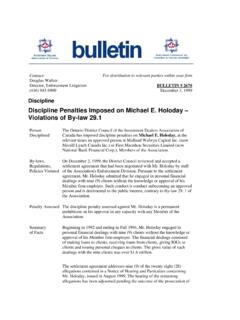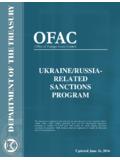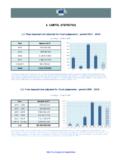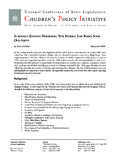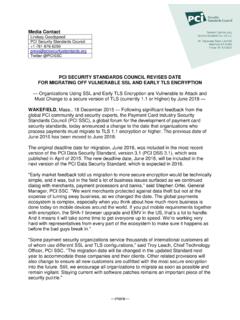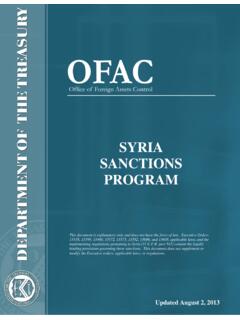Transcription of GUIDELINES FOR IMPLEMENTATION OF ARTICLE 6 OF THE …
1 GUIDELINES FOR IMPLEMENTATION OF ARTICLE 6 OF THE WHO FCTC Price and tax measures to reduce the demand for tobacco 1. INTRODUCTION Purpose of the GUIDELINES Consistent with other provisions of the WHO Framework Convention on Tobacco Control (WHO FCTC) and the decisions of the Conference of the Parties, these GUIDELINES are intended to assist Parties in meeting their objectives and obligations under ARTICLE 6 of the WHO FCTC. They draw on the best available evidence, best practices and experiences of the Parties that have successfully implemented tax and price measures to reduce tobacco consumption.
2 Guiding principles Tobacco use creates a significant economic burden on society at large. Higher direct health costs associated with tobacco-related disease, and higher indirect costs associated with premature loss of life, disability due to tobacco-related disease and productivity losses create significant negative externalities of tobacco use. Effective tobacco taxes not only reduce these externalities through reduced consumption and prevalence but also contribute to the reduction of governments expenditures for the health care costs associated with tobacco consumption. Tax and price policies are widely recognized to be one of the most effective means of influencing the demand for and thus the consumption of tobacco products.
3 Consequently, IMPLEMENTATION of ARTICLE 6 of the WHO FCTC is an essential element of tobacco-control policies and thereby efforts to improve public health. Tobacco taxes should be implemented as part of a comprehensive tobacco-control strategy in line with other articles of the WHO FCTC. The following guiding principles underpin the IMPLEMENTATION of ARTICLE 6 of the WHO FCTC. Determining tobacco taxation policies is a sovereign right of the Parties All parts of the GUIDELINES respect the sovereign right of the Parties to determine and establish their taxation policies, as set out in ARTICLE of the WHO FCTC.
4 Effective tobacco taxes significantly reduce tobacco consumption and prevalence Effective taxes on tobacco products that lead to higher real consumer prices (inflation-adjusted) are desirable because they lower consumption and prevalence, and thereby in turn reduce mortality and morbidity and improve the health of the population. Increasing tobacco taxes is particularly important for protecting young people from initiating or continuing tobacco consumption. Effective tobacco taxes are an important source of revenue Effective tobacco taxes contribute significantly to State budgets.
5 Increasing tobacco taxes generally further increases government revenues, as the increase in tax normally outweighs the decline in consumption of tobacco products. Tobacco taxes are economically efficient and reduce health inequalities Tobacco taxes are generally considered to be economically efficient as they apply to a product with inelastic demand. Low- and middle-income population groups are more responsive to tax and price increases; therefore consumption and prevalence are reduced in these groups by greater magnitudes than in higher-income groups, resulting in a reduction in health inequalities and tobacco-related poverty.
6 Tobacco tax systems and administration should be efficient and effective Tobacco tax systems should be structured to minimize the costs of compliance and administration while ensuring that the desired level of tax revenue is raised and health objectives are achieved. Efficient and effective administration of tobacco tax systems enhances tax compliance and collection of tax revenues while reducing tax evasion and the risk of illicit trade. Tobacco tax policies should be protected from vested interests The development, IMPLEMENTATION and enforcement of tobacco tax and price policies as part of public health policies should be protected from commercial and other vested interests of the tobacco industry, including tactics of using the issue of smuggling in hindering IMPLEMENTATION of tax and price policies, as required under ARTICLE of the WHO FCTC and consistent with the GUIDELINES for its IMPLEMENTATION as well as from any other actual and potential conflicts of interests.
7 Scope of the GUIDELINES These GUIDELINES focus mainly on tobacco excise taxes since these are the primary tool for raising the price of tobacco products relative to the prices of other goods or services. Other taxes or fees, such as income taxes, public fees, and investment encouragement provisions, are not within the scope of these GUIDELINES . Value added tax (VAT) and import duties are briefly referred to in section In a broader perspective, it is important to note that tobacco taxation policies have the ability to affect the consumer price of tobacco products and thus reduce consumption, prevalence and affordability.
8 However, tobacco taxes do not exist in a vacuum and should be implemented as part of a comprehensive tobacco-control strategy alongside other policies undertaken in line with other articles of the WHO FCTC. In that respect, broader economic policy considerations, notably the interrelationship between tax and price policies and income growth, and the consequential social effects on parts of the population, also need to be taken into account. Such an analysis, however, goes beyond the remit of the present GUIDELINES . Illicit trade in tobacco products is addressed in ARTICLE 15 of the WHO FCTC and the Protocol to Eliminate Illicit Trade in Tobacco Products.
9 Many Parties have raised tobacco taxes effectively and experienced revenue increases without increases in illicit trade. Illicit trade in tobacco products undermines price and tax measures designed to strengthen tobacco control and thereby increases the accessibility and affordability of tobacco products. Curbing illicit trade enhances the effectiveness of tobacco tax and price policies in reducing tobacco use and in achieving the public health and revenue goals of tobacco taxation. Use of terms For the purposes of these GUIDELINES : Ad valorem excise tax means a tax levied on selected products based on value, such as retail selling price, the manufacturer s (or ex-factory) price, or the cost insurance freight price (CIF); Affordability means price relative to per capita income; Bootlegging means purchase of tax-paid tobacco products in a lower tax or price jurisdiction for resale in a higher tax or price jurisdiction; Consumption means the absolute quantity of tobacco products used in the aggregate.
10 Cross-border shopping means purchase of tax paid tobacco products in a lower tax or price jurisdiction for use in a higher tax or price jurisdiction; Excise tax or Excise duty means a tax or duty imposed on the sale or production of selected products, such as tobacco products; Forestalling means increases in production or stock of product in anticipation of a tax increase; General sales tax (GST) means a tax imposed on a wide variety of products, typically based on retail price; Import tax or Import duty means a tax imposed on selected imported products, such as tobacco products; Income elasticity of demand means the percentage change in consumption resulting from a one per cent increase in real income; Intensity means the quantity of tobacco products used by the average tobacco user; Mixed tax or Hybrid tax means a tax that includes both a specific tax component and an ad valorem tax component; Negative externality means costs borne by non-users; Prevalence means the percentage of the population that uses a tobacco product.










